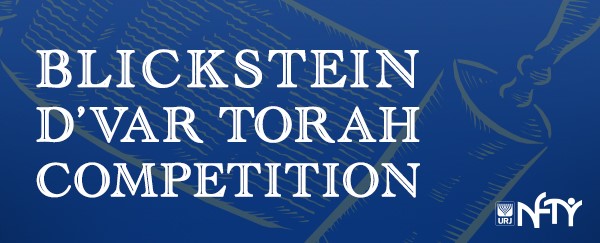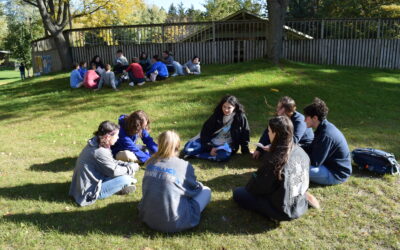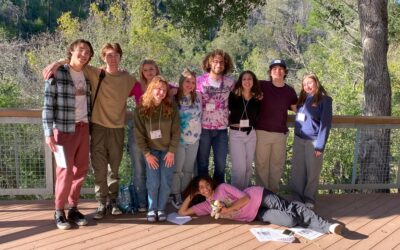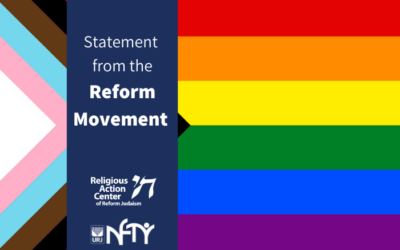This essay is the 3rd place entry for this year’s Blickstein D’var Torah Competition.
By Lex McDermott, RCVP, NFTY SOCAL
The Jewish people set out from Egypt: a group of refugees, a people of pain. Yet forty years later, a people of life arrive in Israel, a group filled with meaning and purpose. Between Egypt and Israel, we undergo a great transition, a series of events that continue to define our Jewish lives and traditions today: the commandments are presented, the tabernacle is built, and in T’tzaveh, God proclaims the rules for the uniform of the high priest, the spiritual and moral leader of the Israelites. In doing so, God builds a model of leadership.
“These are the vestments they are to make: a breastpiece, an ephod, a robe, a fringed tunic, a headdress, and a sash” (Exodus, 28:4).
In detailed instructions, God starts with a description of the ephod, a piece of clothing similar to an apron, which was to be worn over the tunic and below the breastplate. On the attached shoulder pieces, the Israelites are told to place two Lazuli stones, each with six of the names of the tribes of Israel. Called “stones of remembrance” (28:12), they remind Aaron, the high priest at the time, of who he serves, including those who came before and those who will follow him. Engraved on many arks are the Hebrew words “Da lifnei mi atah omed”, “remember before whom you stand”. The Lazuli stones serve the same purpose as these words, as they are a physical reminder of the weight of responsibility Aaron carries.
Uncoincidentally, Aaron’s breastplate features the same names of the tribes of Israel, with each name on one of twelve precious stones. Although seemingly decorative, the breastplate was historically a piece of armor that protected the heart from arrows and swords. Through the metaphor of the breastplate, these same names that bear weight upon the high priest also offer protection. Aaron cannot stand in the sanctuary without all of his garments, including the breastplate. In other words, he cannot face God without the protection of the people, the community. What’s more, the breastplate is tethered to the lazuli stone shoulder-pieces, which makes clear that the strength of community and burden of responsibility are never separate; they always accompany one another, for better or for worse.
In Hebrew, this breastplate is called a “breastpiece of decision”, and it had the power to answer the great questions of the Jewish people. This power was drawn from two stones, called Urim and Thummim, carried behind the breastplate and near the heart. When the high priest needed to answer a difficult question, renowned commentator Ramban explains that the priest would “concentrate on…Urim, and the letters would light up to his eyes”, but when the Hebrew letters from the names of the tribes lit up, their order was not clear. However, Ramban says, “he then immediately concentrated on…Thummim…and there appeared in his heart…the order.” Without marks to indicate when one word ends and the next begins, Thummim gave the priest the insight to interpret the jumbled letters.
The Torah teaches that as leaders, when faced with problems we cannot answer, we must turn to two things: our people, represented in the twelve tribes which contained the letters that glowed, and our heart, the home for the power of Urim and Thummim. When we do not trust the people that we serve and the community that we stand for, we can’t possibly hope to effect change in any real way. When we do not listen to our hearts, we lack the intuition to order clues into a plan of action. Only with balance can we succeed in our leadership.
One of the last symbols on the high priest’s garments is found on the robe’s hem: an alternating row of bells and golden pomegranates. Traditionally, we are taught that the bells around the priest’s feet were to inform those outside the sanctuary that the priest was alive and well before God. The high priest was the only one who could enter the holiest of rooms in the Temple, so if the lower priests outside could not hear the bells, they would know the high priest had sinned before God and was no longer living.
However, the Torah does not state that the bells are for others to know about the High Priest; rather, it says that the bells are so “that he may not die”. This is where the pomegranates come in. A rabbinic tradition explains that a pomegranate has 613 seeds, emblematic of the 613 commandments. The ringing bells draw attention to the row of pomegranates at the priest’s base. Therefore, the bells remind him that if he listens to the commandments, he will not be stricken before God.
T’tzaveh is not just a clothing catalog for the high priest. It teaches us that the most inspired leaders remember they stand on a foundation of laws and traditions; they use the weight of responsibility to remember who they serve; and in times of great decision, they look both inwards and outwards to find the balance between personal vision and communal desire.
The high priest’s garments are not extraordinary. They were created by regular Israelites and donned by a regular man. At the end of the day, they are only items – but their regularity is what makes them special! We don’t need magic or spells to become leaders, nor do we need Aaron’s jewels or cloth. We simply need to remember what we stand on, who we stand for, and what we bring to the table.
The great thing about a robe or breastplate is that when one person takes it off, another can put it on. So, here’s the challenge: embrace the Torah’s teachings of leadership. After all, that’s why we are here. Because as NFTYites, we feel called to a greater responsibility, and know that we already have everything we need to effect change. The Aarons of the past are tiring and beginning to take off their garments of leadership. So wrap yourself in the robe, pull the ephod over your head, and don the breastplate. NFTY, we are ready to fill their shoes.
 Currently serving as the Religious and Cultural Vice President of NFTY SOCAL, Alex (Lex) has been part of NFTY since his freshman year! While not at NFTY, he is a leader on his school’s robotics team, loves playing cello and songleading, and goes to URJ Camp Newman. Lex dreams of working at NASA and then Disneyland once he retires. He is so honored to be a part of the Wendy Blickstein D’var Torah Competition.
Currently serving as the Religious and Cultural Vice President of NFTY SOCAL, Alex (Lex) has been part of NFTY since his freshman year! While not at NFTY, he is a leader on his school’s robotics team, loves playing cello and songleading, and goes to URJ Camp Newman. Lex dreams of working at NASA and then Disneyland once he retires. He is so honored to be a part of the Wendy Blickstein D’var Torah Competition.





